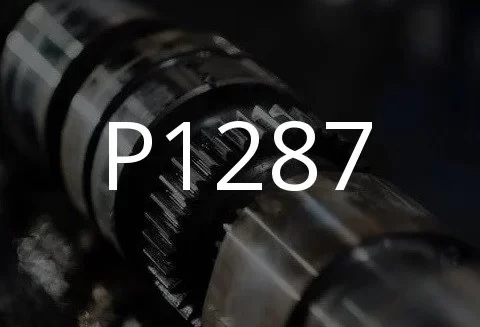
P1287 (Volkswagen, Audi, Skoda, Seat) Turbocharger bypass valve (TC) - open circuit
Content
P1287 – OBD-II Trouble Code Technical Description
Trouble code P1287 indicates an open circuit in the turbocharger wastegate valve circuit in Volkswagen, Audi, Skoda, and Seat vehicles.
What does the fault code mean P1287?
Trouble code P1287 indicates an open circuit in the turbocharger wastegate valve circuit. The turbocharger wastegate (or recirculation valve) plays an important role in the boost system by controlling the distribution of air pressure between the turbocharger and the air manifold. This valve redirects excess air pressure back into the system to prevent excess air being forced into the engine and provide more stable pressure throughout the system. An open in the turbocharger wastegate valve circuit means that the electrical circuit that supplies power to the valve or transmits a control signal is interrupted or damaged. This can be caused by various factors such as broken wiring, damaged connectors, corrosion or a malfunction of the valve itself.

Possible reasons
Several possible reasons for the P1287 trouble code:
- Broken wiring: The wiring connecting the turbocharger bypass valve to the control module or power source may be broken due to physical damage or wear.
- Damage to connectors: The connectors connecting the wiring to the bypass valve may be damaged, corroded, or oxidized, resulting in poor connections and open circuits.
- Bypass valve malfunction: The bypass valve itself may be faulty due to mechanical damage or faulty electrical components.
- Problems with the control module: Malfunctions or errors in the engine control module can cause an open in the bypass valve circuit.
- Corrosion or oxidation of contacts: Corrosion or oxidation on pins or connectors can cause poor contact and open circuits.
- Mechanical damage: Physical damage to the boost system, such as cracks or breaks in lines or valves, can also cause an open in the wastegate circuit.
To accurately determine the cause of the P1287 code, it is recommended that diagnostics be carried out using specialized tools and equipment.
What are the symptoms of a fault code? P1287?
Symptoms for DTC P1287 may include the following:
- Loss of power: Incorrect operation of the turbocharger bypass valve due to an open circuit may result in loss of engine power.
- Acceleration delay: Incorrect operation of the turbocharger due to a faulty wastegate valve may cause delayed acceleration and poor acceleration performance of the vehicle.
- Unstable engine operation: An open circuit in the bypass valve can cause the engine to run rough, manifested by shuddering, rough idling, or speed jumps.
- Increased fuel consumption: Incorrect operation of the boost system due to a faulty wastegate may result in increased fuel consumption due to inefficient combustion.
- Activation of the Check Engine indicator: When P1287 occurs, the Check Engine Light on your vehicle's dashboard will illuminate, indicating a problem with the boost system or wastegate circuit.
- Turbo problems: There may be problems with the normal operation of the turbo, such as insufficient or excessive turbine pressure.
If you notice these symptoms, it is recommended that you contact a qualified technician to diagnose and repair the problem.
How to diagnose a fault code P1287?
The following steps are recommended to diagnose DTC P1287:
- Reading the error code: Use a scan tool to read the P1287 fault code from the Engine Control Module. This will help determine which part of the boost system or wastegate circuit is causing the problem.
- Checking electrical connections: Carefully check the electrical connections and connectors connecting the turbocharger wastegate valve to the control module or power source. Look for corrosion, breaks, short circuits or poor contacts. Make sure all connections are secure and connected correctly.
- Checking the condition of the bypass valve: Check the turbocharger bypass valve itself for physical damage, wear, or blockage. Make sure the valve moves freely and functions correctly.
- Motor controller diagnostics: Carry out additional diagnostics of the engine control module to check its performance and possible errors. If necessary, update the controller software or replace it.
- Checking other components of the charging system: Check the condition and operation of other components of the charging system, such as the turbocharger, air pressure sensors and air filter.
- Testing and diagnostics on the go: After all necessary checks and repairs have been completed, it is recommended to test the vehicle on the road to ensure that it is in good working order and free of errors.
If you have any difficulties or are unsure of your diagnostic skills, it is recommended that you contact a qualified automotive technician or auto repair shop for a professional diagnosis.
Diagnostic errors
When diagnosing DTC P1287, the following errors may occur:
- Limiting diagnostics to one component: The error can be caused by several factors, and focusing on only one component, such as the electrical connections or bypass valve, may result in missing other possible causes of the error.
- Insufficient checking of electrical connections: Poor or faulty electrical connections can be the cause of the P1287 code, so you should carefully check all wires and connectors for corrosion, breaks, or poor connections.
- Misinterpretation of diagnostic data: Incorrect understanding of diagnostic data or incorrect analysis of the operating parameters of the charging system can lead to incorrect conclusions and incorrect determination of the cause of the error.
- Ignoring other possible causes: Trouble P1287 can be caused not only by problems with the wastegate electrical circuit, but also by other factors such as faulty engine controller or mechanical problems. All possible causes must be taken into account.
- Component replacement failed: Replacing components without first diagnosing them or installing new parts incorrectly may not correct the problem and may result in additional repair costs.
To avoid these errors, it is recommended to carry out a comprehensive diagnosis using specialized tools and equipment.
How serious is the fault code? P1287?
Trouble code P1287 indicates a problem in the turbocharger wastegate valve circuit. This can have a serious impact on the operation of the charging system and, consequently, on the performance of the engine. Here's why this can be considered a serious problem:
- Loss of power and efficiency: Improper operation of the bypass valve may result in loss of engine power and reduced engine efficiency. This may affect the overall performance of the vehicle.
- Increased fuel consumption: Improper operation of the charging system can result in incomplete combustion of fuel, which increases fuel consumption and may result in additional refueling costs.
- Engine damage: Continued use with a faulty bypass valve can cause severe engine damage, especially if over- or under-injection occurs.
- Possible implications for other systems: Incorrect operation of the boost system can affect the operation of other vehicle systems, such as the fuel injection system and engine management system.
Overall, while a P1287 code may not immediately stop your vehicle, it does indicate serious problems that can lead to poor vehicle performance and reliability, as well as increased repair and fuel costs.
What repair will help eliminate the code? P1287?
The following repairs may be required to resolve DTC P1287:
- Checking and replacing electrical connections: First, carefully check all electrical connections and connectors in the bypass valve circuit. Make sure that the wiring is not broken, there is no corrosion, and the contacts are well connected. If problematic connections are found, they should be replaced or repaired.
- Checking and replacing the bypass valve: If the problem is not solved by replacing the electrical connections, you should check the condition of the bypass valve itself. If any malfunctions are found, the valve should be replaced with a new one.
- Motor controller diagnostics and maintenance: Perform additional diagnostics on the motor controller to check its functionality and possible errors. If necessary, update the controller software or replace it.
- Checking and replacing other components of the charging system: Check the condition and operation of other components of the charging system, such as the turbocharger and air pressure sensors. Replace or repair faulty components as necessary.
- Clearing the error code from the control module memory: After carrying out repair work and eliminating the problem, it is necessary to delete the error code from the memory of the control module using a diagnostic scanner.
After repairing and removing the error, it is recommended to test the car on the road to confirm serviceability. If the problem persists, additional diagnostics or repairs may be required.

